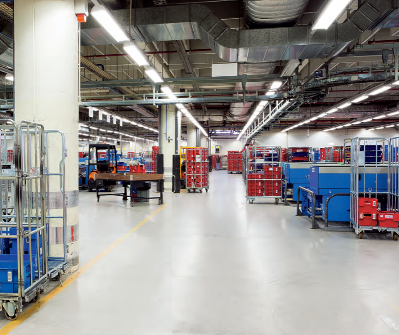Understanding the Suitability of LED Lighting For the Food and Drink Industry

In an effort to run greener, leaner and more sustainable facilities, many food and drink companies have considered making the switch to LED lighting in their production, packaging, warehousing and/or commercial outlets. In fact, interest in and adoption rate of LED for both new construction and retrofit has been growing rapidly over the last two years.
There has been an increasing recognition of LED lighting as a fast and easy change that can deliver a near-instant boost in both sustainability and profitability. However, when presented with LED as a lighting alternative, many facility managers are quick to acknowledge the potential savings, but balk at the cost.
“While there’s no denying that LED fixtures carry an up-front price tag, existing systems have an ongoing cost without the undeniable positive return on investment delivered by LED,” explains Aidan MacDermott, CEO of Energy Automation Systems, a leading specialist in LED Lighting for all internal and external applications.
There are two common misconceptions about the installation of LED lighting – they are too expensive; and they are not bright enough or are otherwise unsuitable for specific applications. Both of these objections are unfounded.
LEDs are too expensive
In the last two years the up-front cost of an LED upgrade has reduced dramatically through massive advances in technology. In addition your existing lighting system has maintenance, labour and parts costs that your LED system will not, virtually eliminating the cost of lighting maintenance for up to 10 years. This allows companies to remove outside contractors that maintain lighting, or free up internal skilled workers to focus on projects that drive efficiency and production.
 “This means that LED offers a lower ‘Cost of Ownership’. Companies that make the switch mostly see a payback on their investment in just one year. Additionally there are Incentives available, often up to 30% of the project costs, to encourage businesses to switch,” points out Aidan MacDermott.
“This means that LED offers a lower ‘Cost of Ownership’. Companies that make the switch mostly see a payback on their investment in just one year. Additionally there are Incentives available, often up to 30% of the project costs, to encourage businesses to switch,” points out Aidan MacDermott.
More importantly LED fixtures consume up to 90% less wattage than conventional fixtures, allowing companies to cut their energy bill by tens of thousands of Euros per year. Also, crucially for industries that require a lot of refrigeration LEDs produce less heat than conventional fixtures helping reduce the load on AC and refrigeration systems.
Consequently, the installation of LEDs offers significant benefits for food and drink companies:
* Lower Entry Levels
* Incentives, Grants available
* Maintenance Free System for 10 years
* Reduction in external contracting
* Massive reduction in ongoing Energy Costs straight onto the bottom line.
LEDs aren’t bright enough or are otherwise unsuitable for my application
“Traditionally the layperson evaluates a light based on the wattage of the bulb. We don’t tend to think in terms of lumen output, efficiency and colour rendering. When looking at a new lighting project we need to retrain ourselves to think in these terms,” says Aidan MacDermott.
 He adds: “Many facility managers think they need to replace a 1,000-watt bulb with a 1000-watt bulb to get the light levels they desire. That’s not the case with LEDs. As a rule of thumb the LED could be just 1/3 the wattage of the existing fitting.”
He adds: “Many facility managers think they need to replace a 1,000-watt bulb with a 1000-watt bulb to get the light levels they desire. That’s not the case with LEDs. As a rule of thumb the LED could be just 1/3 the wattage of the existing fitting.”
Furthermore, LEDs do not degrade over time at the same pace of conventional lighting. Conventional lighting drops to 80% output in the first few months, which is one reason why you never get even light across the facility. To compensate, facilities often over-light with high-wattage bulbs or are changing bulbs on a regular basis. LEDs, on the other hand, lose very little lumen output over the course of a 10-year life span, which means you get brighter, more efficient light over a longer time.
LEDs are now designed to enhance the look of food in retail and display outlets. They are also available IP rated for moisture and dust as well as shatter proof to comply with Health and Safety Regulations.
Financial and Environmental Advantages
LED lighting makes smart financial and environmental sense for food and drink applications. “For any size company, facility or entrepreneur looking to make every penny count, LED lighting is one way to reduce total operating costs and optimize sustainability. LED are the low hanging fruit of the drive to reduce our Carbon Footprint and be more environmentally conscious,” says Aidan MacDermott. “It’s a massive bonus that this comes with a great financial pay off.”
Energy Automation Systems is the preferred supplier for many ‘Blue Chip’ companies and currently provides numerous large OEM customers and end users with bespoke solutions meeting their exact needs and solving their issues.
For an initial consultation on how a LED retrofit would benefit your business and how to claim the Incentives that are available contact Gerry on 085 1419 518 or email:gerry@easilightandpower.com.

































